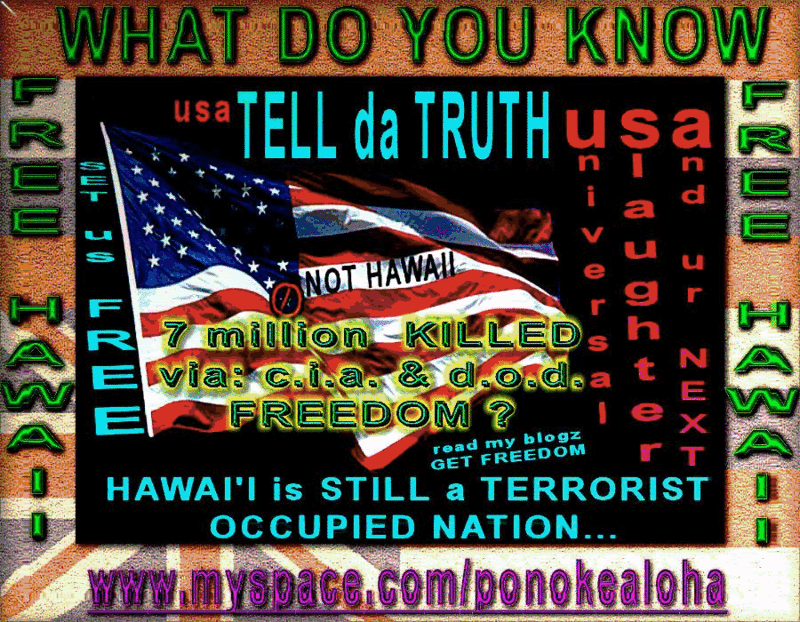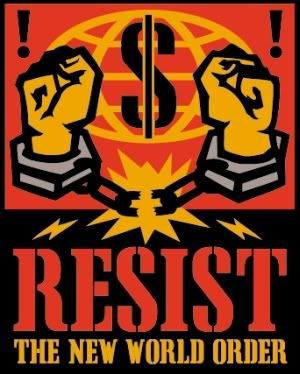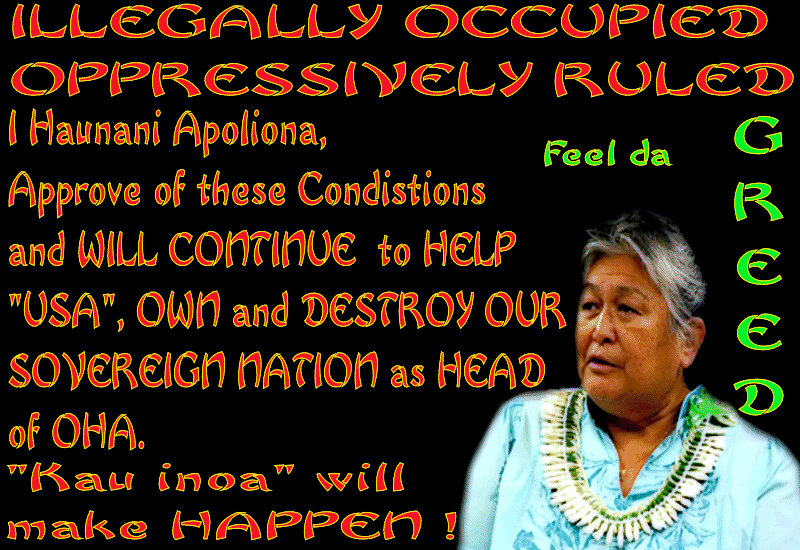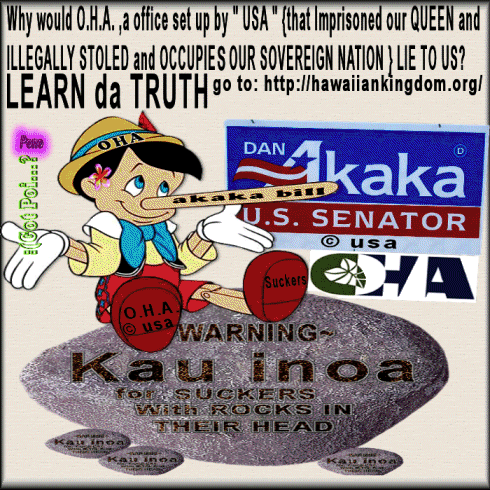MONSANTO da{ SNAKE } uses GREED = da { APPLE } TO HELP CONINUE TO USE, HAWAI'I'S AINA and POPULATION {SCHOOL KIDS INCLUDED} as LAB RATZ and GUINEA PIGS on { UNTESTED G.M.O'S and PROVEN POISONOUS CANCER TOXIC SPRAYS! } WITH A CORRUPT PUPPET GOVERNMENT THAT TREATS ITS PUBLIC AS SHEEPLE WAITING TO BE SHEARED OF THEIR HEALTH {SAFE: WATER ,AIR , LAND} and LIVES!
School Foundation receives Monsanto grant
Molokai Times, March 4, 2008
The Friends of Molokai High and Middle Schools Foundation has received a $6,500 grant from the Monsanto Fund to support science education on Molokai.
Last year, a $10,000 grant from the Monsanto Fund was used to purchase a wide array of educational materials and supplies for Molokai Middle School and Molokai High School. The high school used the funds to help re-build its science facilities after losing classrooms and a lab when the high school and middle schools were separated in 2005.
“Teachers at both schools benefited tremendously from the Monsanto Fund's generosity last year and will again be grateful for the assistance this year,” said Camie Kimball, president of the Foundation. “Last year, the grant money went toward re-building a science lab for the high school and the middle school purchased microscopes and slides that were used to enhance our science curriculum. This grant will go a long way toward supporting our teachers and students.”
The grant is part of the Monsanto Hawaii Science Education Fund, a program established by the Monsanto Fund in 2005 to support science education in public schools serving students at the intermediate, high school and college grade levels throughout Hawaii. The Friends of Molokai High and Middle Schools Foundation will be administering the grant on Molokai.
The Molokai High and Middle Schools Foundation is a 501(c)3 non-profit organization established “to enhance the quality of student life at Molokai High & Molokai Middle Schools by providing competitive opportunities that strengthen a healthy & caring community.” Tax-deductible donations to the Foundation are welcome.
The Monsanto Fund is the philanthropic arm of the Monsanto Company. Incorporated in 1964, the Fund's primary objective is to improve the lives of people by bridging the gap between their needs and their resources. The Monsanto Fund is focused on grant-making in four main areas: nutritional well-being through agriculture; science education, primarily on professional development for teachers; the environment, which includes conservation, protection of biodiversity, clean water and restoration of wildlife habitat; and improving the quality of life in communities where Monsanto employees live and work.
Mahalo;Nini'aneGenetic Foods/Monsanto Revealed 1/3The Genetic Conspiracy (2/3) - about MonsantoThe Genetic Conspiracy (3/3) - about Monsanto


 GMO taro bill moves forward (Hawaii)Would put moratorium on developing GMO strainsTHE GARDEN ISLANDby Rachel GehrleinMar 03, 2008Supporters of a Senate bill aimed to impose a 10-year moratorium on the developing, testing and raising of genetically modified taro are relieved, after waiting for more than a year, that the bill will be heard on March 19.After Senate Bill 958 was first introduced in January 2007 it failed but was carried over to the 2008 legislative session.“We were very stubborn telling them (lawmakers) the bill needs to be heard,” said Chris Kobayashi, a Kaua‘i taro farmer. “The 10-year moratorium is just a time out so things could be explored further.”Jeri DiPietro of GMO Free Kaua‘i agrees.“(The bill) asks for a temporary moratorium, a time out,” DiPietro said.“It is a moment to evaluate and use precaution in a new situation. If only a second look had been given before the Department of Agriculture allowed the importation of the apple snail and let it rage out of control into pest status.”Kobayashi said the idea of GMO taro is scary because on the genetic level, if the taro is modified from the original plant, “we can never bring it back.”“As farmers, we wouldn’t be able to see the difference,” Kobayashi said. “There is a lot of sharing of huli (the starts of taro) between farmers.”Rep. Mina Morita, D-Kapa‘a-North Kaua‘i, said taro is a food crop that has cultural implications that scientists need to be aware of.“The scientists should be responsible to the individual,” Morita said. “If individuals think GMO research is not necessary at this time, and the farmers don’t want to grow it and the consumers don’t want to eat it, who does it benefit?”Wayne Nishijima, associate dean with the University of Hawai‘i’s College of Tropical Agriculture and Human Resources, said the university signed an agreement with the Royal Order of Kamehameha I a few years ago to not conduct GMO tests on known Hawaiian varieties of taro.But Nishijima said the Hawaiian taro’s susceptibility to various pests, such as Phytophthora colocasiae — a fungus-like organism that invaded American Samoa taro in 1993 — could be solved with genetic engineering.“The current GE project (at UH) is on Chinese taro to develop resistant varieties to Phytophthora blight,” Nishijima said. “No Hawaiian varieties have been genetically engineered, but we have researchers doing traditional breeding to develop Phytophthora resistant cultivars, but it takes time.”But because none of the Hawaiian varieties have Phytophthora resistance, taro from other locales must be used, Nishijima said.Nishijima feels that because UH has already signed a moratorium, there is no need for a law to be passed to create another moratorium.“In my opinion, extending the moratorium to include genetic engineering of non-Hawaiian taro varieties does not follow their argument of infringement of their cultural rights and heritage,” Nishijima said. “What it will do is significantly limit our ability to address current and future problems. If the bill passes, it will put taro in a position to make it vulnerable to the devastation by new invasive species.”In support of SB 958 imposing the moratorium, the Kaua‘i County Council has drafted Resolution 2008-04. The resolution is scheduled to be heard at the council meeting on March 12.“We need as many testimonies as is possible to support SB 958,” DiPietro said in an e-mail. “You need not be a farmer. Consumers have a right to a choice too.”GMO Free Kaua‘i will also hold a rally in support of the SB 958 today from 4 to 6 p.m. at the gateway at Lihu‘e Airport.Mahalo: Stop Monsanto.org
GMO taro bill moves forward (Hawaii)Would put moratorium on developing GMO strainsTHE GARDEN ISLANDby Rachel GehrleinMar 03, 2008Supporters of a Senate bill aimed to impose a 10-year moratorium on the developing, testing and raising of genetically modified taro are relieved, after waiting for more than a year, that the bill will be heard on March 19.After Senate Bill 958 was first introduced in January 2007 it failed but was carried over to the 2008 legislative session.“We were very stubborn telling them (lawmakers) the bill needs to be heard,” said Chris Kobayashi, a Kaua‘i taro farmer. “The 10-year moratorium is just a time out so things could be explored further.”Jeri DiPietro of GMO Free Kaua‘i agrees.“(The bill) asks for a temporary moratorium, a time out,” DiPietro said.“It is a moment to evaluate and use precaution in a new situation. If only a second look had been given before the Department of Agriculture allowed the importation of the apple snail and let it rage out of control into pest status.”Kobayashi said the idea of GMO taro is scary because on the genetic level, if the taro is modified from the original plant, “we can never bring it back.”“As farmers, we wouldn’t be able to see the difference,” Kobayashi said. “There is a lot of sharing of huli (the starts of taro) between farmers.”Rep. Mina Morita, D-Kapa‘a-North Kaua‘i, said taro is a food crop that has cultural implications that scientists need to be aware of.“The scientists should be responsible to the individual,” Morita said. “If individuals think GMO research is not necessary at this time, and the farmers don’t want to grow it and the consumers don’t want to eat it, who does it benefit?”Wayne Nishijima, associate dean with the University of Hawai‘i’s College of Tropical Agriculture and Human Resources, said the university signed an agreement with the Royal Order of Kamehameha I a few years ago to not conduct GMO tests on known Hawaiian varieties of taro.But Nishijima said the Hawaiian taro’s susceptibility to various pests, such as Phytophthora colocasiae — a fungus-like organism that invaded American Samoa taro in 1993 — could be solved with genetic engineering.“The current GE project (at UH) is on Chinese taro to develop resistant varieties to Phytophthora blight,” Nishijima said. “No Hawaiian varieties have been genetically engineered, but we have researchers doing traditional breeding to develop Phytophthora resistant cultivars, but it takes time.”But because none of the Hawaiian varieties have Phytophthora resistance, taro from other locales must be used, Nishijima said.Nishijima feels that because UH has already signed a moratorium, there is no need for a law to be passed to create another moratorium.“In my opinion, extending the moratorium to include genetic engineering of non-Hawaiian taro varieties does not follow their argument of infringement of their cultural rights and heritage,” Nishijima said. “What it will do is significantly limit our ability to address current and future problems. If the bill passes, it will put taro in a position to make it vulnerable to the devastation by new invasive species.”In support of SB 958 imposing the moratorium, the Kaua‘i County Council has drafted Resolution 2008-04. The resolution is scheduled to be heard at the council meeting on March 12.“We need as many testimonies as is possible to support SB 958,” DiPietro said in an e-mail. “You need not be a farmer. Consumers have a right to a choice too.”GMO Free Kaua‘i will also hold a rally in support of the SB 958 today from 4 to 6 p.m. at the gateway at Lihu‘e Airport.Mahalo: Stop Monsanto.org






 Course change on Stryker unlikely despite environmental harmhttp://starbulletin.com/2008/03/04/editorial/editorial01.htmlTHE ISSUE - A draft environmental review says Hawaii is the best location for a Stryker brigade.SIGNIFICANT environmental consequences aren't enough for the Army to relocate a Stryker brigade it began to establish in Hawaii nearly seven years ago.Despite findings that threatened and endangered species, air quality and natural habitats along with cultural resources would suffer, the Army has decided national security needs and the state's geographic advantages trump those concerns.Barring further legal challenges, it appears the combat team's 4,105 soldiers and 1,000 vehicles -- including more than 320 eight-wheeled, 19-ton armored Strykers -- will be based permanently in the islands.Hawaii's congressional delegation and military officials say they are certain harm will be mitigated. Residents will have to take them at their word since few have the wherewithal to make sure that happens. The Army would do well to allay fears and mistrust developed over the years in a state that has accommodated an overwhelming share of military operations.A supplemental environmental study the Army conducted found that the Stryker would have significant effects in the islands. The second study was required by a federal court that found the Army violated the law when it did not adequately consider other sites for the brigade in the first go-round.The supplemental review determined that the brigade would increase noise, soil erosion, habitat impairment, malignant weeds and hazardous wastes at all the sites, Hawaii, Alaska and Colorado, though the degree of environmental harm would be most substantial here.However, in judging other factors -- housing shortages, training ranges, deployment schemes and the feasibility of stationing other types of combat units in Hawaii and costs -- the Army picked the islands.The financial benefits have been persuasive and will remain so as the state's economy, particularly in construction, begins to soften. Almost $700 million in 28 construction projects are planned or in the works for the brigade on Oahu and Hawaii island. Local business also welcome spending by thousands of soldiers and their families.Stryker opponents had argued that economic benefits would have come anyway since the Army needed to upgrade facilities and had planned to bring in one kind of unit or another, if not the Stryker brigade, and that the environmental trade-off was too great.While an argument can be made that Hawaii's unique environment should be given greater consideration, its strategic location -- and the millions of dollars the Army has already spent for Stryker projects here -- makes a course reversal improbable.
Course change on Stryker unlikely despite environmental harmhttp://starbulletin.com/2008/03/04/editorial/editorial01.htmlTHE ISSUE - A draft environmental review says Hawaii is the best location for a Stryker brigade.SIGNIFICANT environmental consequences aren't enough for the Army to relocate a Stryker brigade it began to establish in Hawaii nearly seven years ago.Despite findings that threatened and endangered species, air quality and natural habitats along with cultural resources would suffer, the Army has decided national security needs and the state's geographic advantages trump those concerns.Barring further legal challenges, it appears the combat team's 4,105 soldiers and 1,000 vehicles -- including more than 320 eight-wheeled, 19-ton armored Strykers -- will be based permanently in the islands.Hawaii's congressional delegation and military officials say they are certain harm will be mitigated. Residents will have to take them at their word since few have the wherewithal to make sure that happens. The Army would do well to allay fears and mistrust developed over the years in a state that has accommodated an overwhelming share of military operations.A supplemental environmental study the Army conducted found that the Stryker would have significant effects in the islands. The second study was required by a federal court that found the Army violated the law when it did not adequately consider other sites for the brigade in the first go-round.The supplemental review determined that the brigade would increase noise, soil erosion, habitat impairment, malignant weeds and hazardous wastes at all the sites, Hawaii, Alaska and Colorado, though the degree of environmental harm would be most substantial here.However, in judging other factors -- housing shortages, training ranges, deployment schemes and the feasibility of stationing other types of combat units in Hawaii and costs -- the Army picked the islands.The financial benefits have been persuasive and will remain so as the state's economy, particularly in construction, begins to soften. Almost $700 million in 28 construction projects are planned or in the works for the brigade on Oahu and Hawaii island. Local business also welcome spending by thousands of soldiers and their families.Stryker opponents had argued that economic benefits would have come anyway since the Army needed to upgrade facilities and had planned to bring in one kind of unit or another, if not the Stryker brigade, and that the environmental trade-off was too great.While an argument can be made that Hawaii's unique environment should be given greater consideration, its strategic location -- and the millions of dollars the Army has already spent for Stryker projects here -- makes a course reversal improbable.

 mahalo:Nini'aneFreeHawaiiBanner
mahalo:Nini'aneFreeHawaiiBanner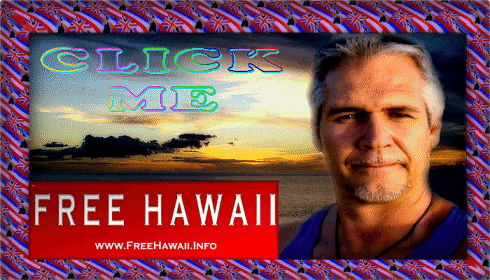
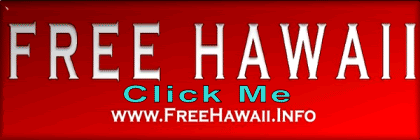

 SINCE HAWAI'I IS STILL ILLEGALLY OCCUPIED & RULED ,THIS IS THE SAME FUCK ASS ADDITUDE THEY FLOOD OUR SOVEREIGN "NEUTRAL" NATION & CULTURE WITH !!!
SINCE HAWAI'I IS STILL ILLEGALLY OCCUPIED & RULED ,THIS IS THE SAME FUCK ASS ADDITUDE THEY FLOOD OUR SOVEREIGN "NEUTRAL" NATION & CULTURE WITH !!!





